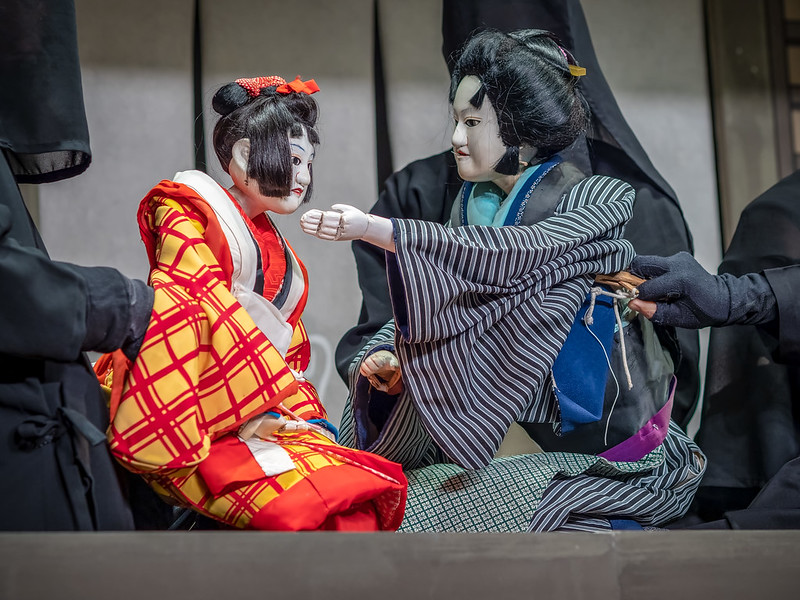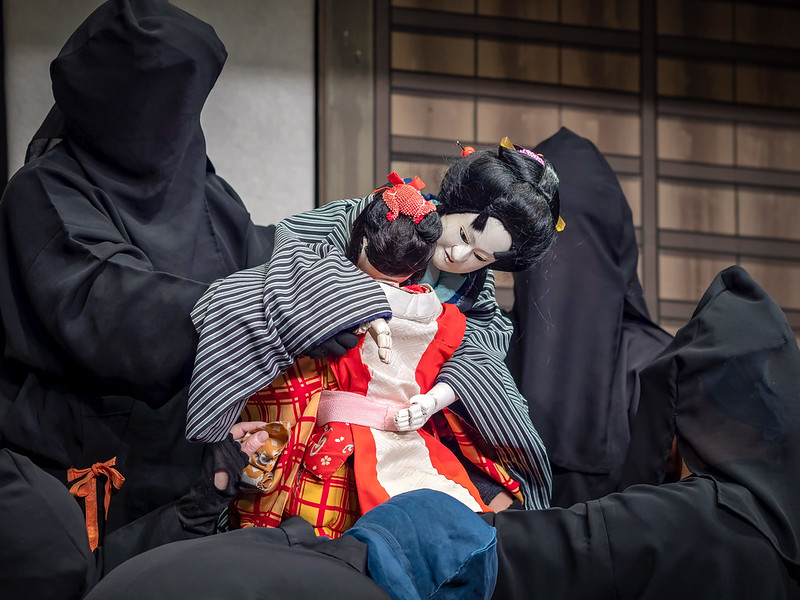Bunraku, the Japanese form of puppet theater is definitely the most striking tradition of puppetry in the world. The stage is large, the puppets are large and some puppets are so complex it takes three puppeteers to manipulate one.
Puppetry has deep roots in Japan. Like puppetry around the world, it got its start as ancient rites where the puppets served as representatives of the deceased.
In the Heian period (794-1185), there is written evidence about groups of traveling puppeteers who used simple, one man operated puppets. Another form of art in that time period was storytelling. Traveling storytellers would narrate tales about famous battles of the feudal period.
Bunraku is a Synergy of Puppetry, Storytelling and Music
By the end of the 16th century, bunraku had evolved to a point where the puppeteers and storytellers began cooperating. Then a third group of artists joined to create a new art form through the addition of music. Shamisen (Japanese string instrument similar to a lute) players would pluck their instruments to add music to the drama and excitement. This fusion of three art forms, puppetry, storytelling and music reached its artistic peak in the early 17th century. During the 18th century, the puppets that were once rather small grew to a size of over 3 feet. The mechanisms to manipulate the puppets became so complex that now three puppeteers were required to operate one puppet. The synchronization of these three puppeteers is what makes it possible to create the illusion of the puppets being alive. The chief puppeteer operates the puppet’s head and right hand. The second puppeteer operates the puppet’s left hand and the third puppeteer is the “leg handler.” Only some of the puppets have movable fingers or facial features. What is unusual about bunraku when compared to other forms of puppetry is that all puppeteers are dressed in black and in full view of the audience.

The Puppets
Bunraku puppets can be as large as four feet in height. They don’t have full bodies. Most of the body is constructed of fabric in the shape of a kimono. Only the head, hands, legs and feet are carved by specialists. The puppet heads are attached to a rod which the chief puppeteer operates. If the puppet has movable facial features, then strings are used to manipulate the eyes, noses, eyebrows and mouth. The size of the head depends on the character. Heroes and powerful beings have larger heads than lesser characters like common villagers and minor supporting characters.
The rod which supports the head is attached to a board which creates the shoulders. Pieces of fabric are hung from this board. The puppets don’t have arms. A string attaches the wooden hands and the forearms to the shoulder board. Rods are connected to the hands which are operated by the chief puppeteer and the puppeteer. The hands are jointed so that the puppet can handle props, such as a cigarette, sword or fan. Male puppets have legs and feet whereas female puppets don’t have feet because traditional clothing completely covers the bottom half. Most of the body and clothing are made by the puppeteers themselves.

The Storyteller or Narrator
Even though it is fascinating to watch the puppets being brought to life by the puppeteers, an integral part of the show are the gidayu narrator and the shamisen player. They sit in full view of the audience on a small platform to the right side of the stage wearing formal attire of the Edo period (1603-1867).
Similar to the synergy of the three puppeteers operating one puppet, the rapport between the gidayu narrator and the shamisen player adds expressive drama to the action of the puppets.
The vocal range and repertoire of the gidayu narrator is beyond belief. He is not only the narrator of the story – he does the lines of all of the puppet characters either by speaking or singing. He can change the expression of his voice from whispers to heartbreaking laments and then on to furiously angry shouts.
The Music
The shamisen is a three stringed instrument, similar to a lute. It is played with a large bone plectrum which accentuates the narration and the stage action. The shamisen was introduced to Japan from China and became the fashionable instrument of the Edo period.
Even though puppet theater is often thought of as children’s entertainment, the Japanese consider Bunraku a significant form of traditional art. The plays are based on tales of past centuries and taken from Japanese history and legends. The performances captivate the audience with stories of heroism, tragic love and the supernatural. Though the plays portray times and traditions long past, they often are focused on human emotions that present day audiences can relate to.
Source:
Japan Objects
Traditional Kyoto
